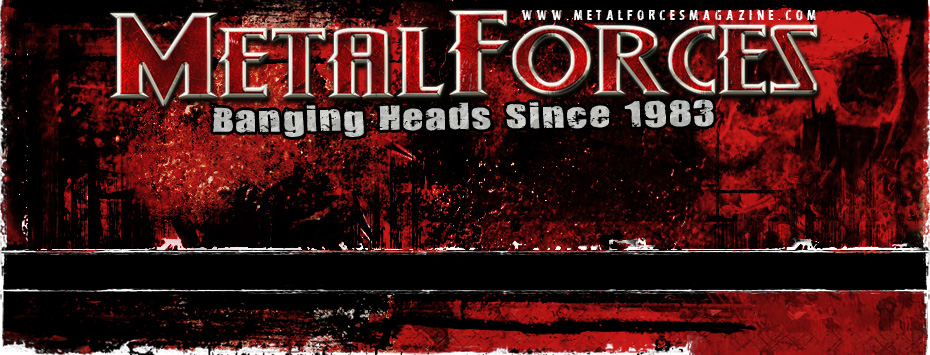
AT THE GATES – Music And The Labyrinth
Anthony Morgan
October 2014
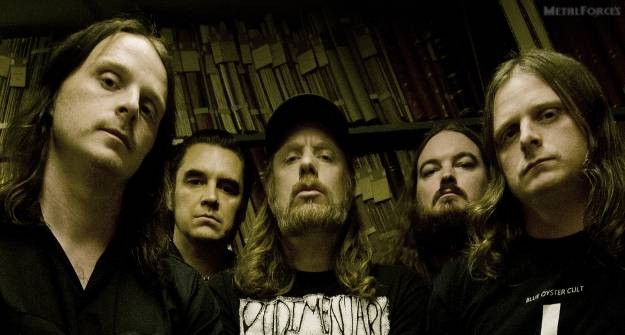 At The Gates (l-r): Anders Björler, Adrian Erlandsson, Tomas Lindberg, Martin Larsson and Jonas Björler |
![]()
Gothenburg, Sweden-based melodic death metal outfit At The Gates’ initial run lasted from 1990 until 1996, that six-year timeframe spawning four studio full-lengths in all; The Red In The Sky Is Ours (July 1992), With Fear I Kiss The Burning Darkness (May 1993), Terminal Spirit Disease (July 1994), and Slaughter Of The Soul (November 1995). A reunion was confirmed during October 2007, although a fifth studio proper has taken six years to surface, arriving in the shape of October 2014’s At War With Reality.
“We grew closer with the 2008 reunion, which was a fast-paced reunion tour for only four or five months,” remembers Anders Björler, guitarist and co-founder of At The Gates. “We felt in that sense, we had a lot of fun and we were overwhelmed by the positive response. At the same time, we didn’t have time to play anywhere, so that’s why we continued in 2011. Over the next couple of years, the whole thing grew on us. We wanted to revisit the creative side of us, and just try to write music again. We originally talked about maybe doing a cover album, or something like that, and it was my reaction against that. After I finished my solo album, which was made after I left The Haunted, I felt that I wanted to write some metal again. At The Gates was just there for me – it was obvious. I wrote a song that I sent to Tomas (Lindberg, vocals) and Jonas (Björler, bassist and identical twin brother) just to get a response off of it, and the rest is history. That’s how it came about.”
Authoring numbers which matched or even surpassed the legacy of At The Gates’ recorded output wasn’t an initial concern. “There wasn’t so much worry initially, because we didn’t really know if there was gonna be an album,” the axeman explains. “We just tried and wrote some songs, just to try to get the feel of it. When we then had four or five songs done, it dawned on us that ‘Yeah, there’s gonna be another album. That sounds fucking fantastic.’ Still though, we kept it very intimate. Twenty people knew about it, but it was kind of a secret, so that’s why we didn’t feel pressured at all. There was no outside expectation, because no-one knew about it – it was like a big secret.
“I guess there’s a legacy with Slaughter Of The Soul and all that, but that all happened after we split up – a couple of years after – so that was never a part of us back then when we were active. We were considered a really small band when we split up, pretty underground. I guess what’s happened in the past 20 years, it’s been growing into this entity without our help. It’s just been word of mouth between people and journalists that have name-dropped us, and other artists. We’re just overwhelmed by this big thing that it’s become. We were just sitting on the sidelines, and watching it happen.”
Anders wrote the majority of compositions for At War With Reality. “I started the initial process, as well,” he notes. “Back in the day, me and Jonas wrote maybe 50 / 50, but nowadays I wrote 70% and he wrote 30% maybe. He came in with two or three songs, because he started to write songs. Back in the day, we all had to learn the song physically in the rehearsal room all together, and then try to get it down, record on a tape recorder, and then listen back. Today though, it’s so much easier with recording software.
“You can record a very professional sounding demo at home and just distribute it on the internet, and everybody can listen. If there are some changes needed, you can do them really quick with a click of the mouse – really, really quick. Of course, technology has helped improve writing and arranging songs. It’s become much more efficient and simple, so a lot of things have changed with the techniques of it. I want to maybe re-experience the first couple of albums, which are darker and more complex in a way. It wasn’t immediately the Slaughter Of The Soul sound that we were after; I wanted something darker and more melodic this time.”
Nineteen years separate the respective issues of At War With Reality and Slaughter Of The Soul, which for a number of years was the last At The Gates studio opus to feature the songwriting prowess of the Björler brothers. “It was a different period in our lives,” the composer reflects. “It doesn’t really sound exactly as it did in ’95; we’ve changed a little, and then we feed off each other of course. If I write something, he gets inspired by that, and then he writes something to maybe match that or suit that in some way. If he writes something, it’d be the other way. If he writes something I don’t like, I just react to that, and make something else. Of course we trigger each other all the time, but to say who writes what is pretty difficult this time. It’s not as easy as to say that he writes all of the melodic stuff, because I do as well. There’s no significant style. This is maybe the closest collaboration so far, because we were involved so much with the arrangements – everybody. I wrote the skeletons of the songs, and then we added some of Jonas’ stuff to complement.”
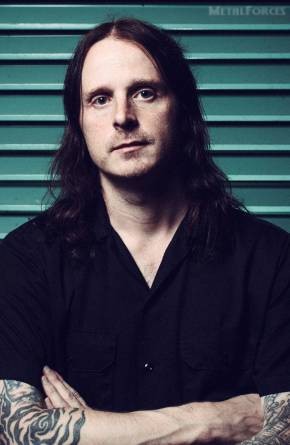
|
At War With Reality “is pretty diverse and pretty dynamic,” Anders contends. “I think we wanted to have this condensed into a history or discography of the old At The Gates – I mean, all albums. Every little part of it is reminiscent of something in our past, but at the same time it’s really fresh and new, and striving to pave new grounds of course – especially sound-wise and production-wise. We wanted something maybe a bit more modern, but also at the same time very classic and not super-polished. A little bit more rough, maybe more multi-layered. More of that dynamic sound. Jens is very good at that – Jens Bogren who mixed the album. I guess melodically or maybe sound-wise we wanted to rediscover the old albums a little bit more, but yeah, I would say that the album is condensed. You can hear all of our history in there.”
At The Gates’ first four studio full-lengths can arguably be separated into two distinct musical periods. “The first couple of albums are very experimental, mainly due to the fact that we didn’t have an established style,” the axe-slinger critiques. “We were still looking and still trying and experimenting, and of course we were fairly new at playing our instruments. I had only been playing guitar for six months before recording Gardens Of Grief (1991), so writing and recording was pretty quick. At the same time, we wanted to impress everybody by having a hundred riffs in each song and super-complex arrangements, and stuff like that. Both are very early trademarks on the first records, and then when Alf (Svensson, guitarist from 1990 until 1993) left the band, we started to delve into more traditional songwriting.
“We were very much influenced by regular rock song structures like Thin Lizzy and stuff like that, but in an extreme way. I think you can hear the more traditional songwriting structures on Terminal Spirit Disease and Slaughter Of The Soul, so of course there’s a difference. The timespan was only like five years though, so a lot of things happened. We started playing in ’90, and already in ’94 we were so much better at playing our instruments. A lot of stuff happened. It was also a question of recording budgets. We couldn’t really afford a studio, so that’s why it’s really rushed on the earlier records and it doesn’t very good – we played a lot of mistakes you can hear on the albums. That affected us, not having too much time in the studio.”
Listeners are arguably more familiar with Terminal Spirit Disease and Slaughter Of The Soul, as opposed to The Red In The Sky Is Ours and With Fear I Kiss The Burning Darkness. “Mainly due to the fact that the first two albums were on Deaf Records, which was a sub-label of Peaceville,” Anders reckons. “Then when Terminal Spirit Disease came out on Peaceville, distribution was better. The next big step was signing with Earache Records, and benefiting from better distribution. We were doing real press trips, a lot of interviews, a professional music video (‘Blinded By Fear’). Of course everything helps, like being on a bigger label. Of course, more people will know about Slaughter Of The Soul, because it was more exposed, and then the fact that the old albums are a bit hard to get into. You maybe have to listen to them a couple of hundred times (laughs). You can get into Slaughter Of The Soul just after a few listens, but the earlier albums are a bit more demanding.”
Having accrued an additional 19 years of experience, a band of veterans cut At War With Reality. “Style-wise, it could’ve worked in the past I guess, but the thing I think is the most representative of today is that it’s so much more well-played and thought through and everything,” the musician observes. “The tempos in the songs are not stressed, for example. It’s really relaxed, but still has that edge. I think you can hear a maturity, without it being boring. It’s hard to describe maybe, but the earlier records are very reminiscent of that youthful ambition, while now we’re in some kind of comfort zone where we know which position, and which song structures, and which playing techniques we sound the best. We have a better knowledge of ourselves today, I think.”
Anders’ approach towards guitar parts with respect to the platter was to achieve further melody. “Especially like on Slaughter Of The Soul,” he cites. “That’s also something that’s been with me since I was a kid. I have always enjoyed melodic music, so it could be extreme music, but I always like melody as well. This time, I think I was maybe more inspired by everything that I’ve listened to in the past 20 years, which could be anything from ambient music to jazz, classical opera, and very experimental music. Everything served as an influence. Maybe it’s a bit darker than the earlier stuff, and that’s maybe from Russian classical music like (Sergei) Prokofiev and stuff like that. Everything that I listened to served as an influence. The key for me at least was to make a very melodic album, but at the same time a very diverse album, so you have some melancholy and dissonance even here and there to make it more interesting.”
Vocalist Tomas Lindberg handled lyrical duties for At War With Reality. “He was very much into magic realism, which is a literary genre that started in maybe the 50s or 60s in South America,” the guitarist informs. “It was a way of writing in a very metaphorical, critical way to avoid censorship at the time. I think he just adapted that style of writing, and just came up with this concept for the whole album being like that, and also with the artwork and everything. There was real thought behind everything, to make this kind of landscape. It also ties in with the intro, which is a very film-like intro, so everything’s tied together.”
When it comes to penning lyrics, Tomas’ bandmates leave the frontman to his own devices. “Why not?,” Anders queries. “He’s a great lyricist, and we know that he writes very good lyrics, even though it’s personal. We basically left that to him. He wrote everything. There’s no need to interfere if something is good I think, so yeah. It was a good theme to work around though, making a whole concept album. In many ways it’s reminiscent of the old stuff as well, just the existential point of view that’s very much on Slaughter Of The Soul, but written in another technique so to speak.”
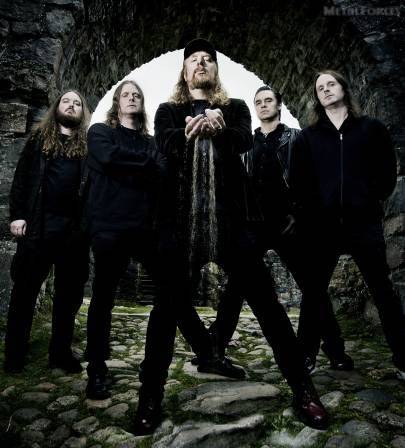
|
Such comments suggest At War With Reality is lyrically a concept effort. “A concept, a theme,” the co-founder lists. “I don’t know what’s the difference, if it’s the same or not. It’s hard to answer. I guess we wanted to establish some kind of history basically, so that the listener goes on some kind of journey. At the same time, it was very important to have a very powerful artwork, a very simple cover artwork. Then you open up the booklet, and it’s a whole other story. It’s almost like a storybook, so yeah, the lyrics are very important to Tomas. That inspired me to write music, and vice versa. It’s considered to be a whole experience for the listener.”
Romanian artist Costin Chioreanu designed the cover piece for the record. “Costin did some T-shirt designs for us in the past,” Anders shares. “He also did my solo album Antikythera (November 2013). We like his style very much. It’s very cartoon’y, but at the same time it’s very dark. We thought that it would represent the music very, very good, so we started working with him pretty early on. We gave him at first some lyrics to work with, and then we gave him some songs.”
At War With Reality was recorded at Gothenburg’s Studio Fredman with Fredrik Nordström, as was the case for albums three and four. “Fredrik was a really inspirational figure from the mid-90s,” the axeman credits. “He helped a lot of us bands from the Gothenburg area – like At The Gates, Dark Tranquillity, In Flames – to make professional recordings that sound good. First of all, we weren’t very good at playing, and there weren’t many studios in Gothenburg with technicians who knew how metal should sound. He was the driving force behind the Gothenburg sound, in many ways. We wanted to rediscover that collaboration with him, and friendship. The fact of the matter is that there aren’t many studios left in Gothenburg, so it wasn’t that hard of a choice for us to make. We wanted to record in Gothenburg, since everybody has obligations here – family, work, and stuff like that. So yeah, we chose Fredrik, and it was amazing. He also has a great technician called Henrik, who did a lot of the recording.
“I think there’s some kind of trust in that old entity somehow. Basically, it doesn’t have to be Fredman doing that, but it felt good in a way to revisit that kind of feeling from the past. He made a very good job on Slaughter Of The Soul, so why not? Other than that, there wasn’t any real reason why we chose to work with some guys again. We didn’t work with Kristian Wåhlin for the cover artwork for example, so it’s not the same as the past on every level. We wanted to rediscover some of it, but not all. You have to reinvent yourself, and try new ways of course at the same time. You can’t just copy the past; you have to actually create something new.”
‘Death And The Labyrinth’ was chosen to be the album’s lead composition. “I think that song is actually about describing and explaining the kind of style that the album is,” Anders examines. “It’s after the intro for the album, and that song is made to kind of explain the lyrical theme in a way. It’s metaphorically written, so it’s not very obvious though. That’s what he explained to me, what it’s about.
“Musically it has elements of everything; it’s like the whole history of it. It starts with a very traditional death metal tremolo-like riff, and it goes into a more thrashy Slaughter Of The Soul. Then it has an almost melodic chorus that could be on any album, and then it just goes into this kind of thrash-o-rama piece. It’s very diverse, but at the same time it has ingredients from everything. I think that’s why we chose it as the starting song on the album and the first music video.
“We started talking with Patric (Ullaeus, Revolver Film Company) pretty early about doing a different kind of video, and not a regular performance video. The same as with the cover artwork and the lyrical theme, it’s based around the idea that we had. It’s centred around magic realism as well, just the reality concept. He made a very, very weird video with very, very short instructions from us, so it was very experimental in every sense. Yeah, we’re very happy about it. It’s not your traditional music video at all, but I think it suits the song perfectly.”
Another central composition happens to be ‘Heroes And Tombs’. “The concept on that one is, I think we had a few fast songs for the album already,” the songwriter divulges. “We were thinking maybe to do something a bit more mid-tempo, just to get a kind of variety going. That was maybe after four or five songs we wrote something like that. The mindset was to have something in the style of ‘Seasons In The Abyss’ (from the October 1990 album of the same name), like a very Slayer-esque beginning. Then it becomes a more traditional mid-tempo song, which we’ve never done in At The Gates before. In many ways that was paving new ways, but then of course using a very melodic chorus and a very melodic solo. It has the ingredients of classic At The Gates as well. Of course, it was used to create diversity.
“We have a music video planned for ‘Heroes And Tombs’, which is gonna be released in maybe one or two weeks. I can’t tell you anything about it, because it’s a big secret. It’s gonna be pretty much self-explanatory, anyway.”
Additional track ideas surfaced during writing sessions for At War With Reality. “We had some ideas left over in the end, but there are two bonus tracks on the limited edition,” Anders reveals. “They’re called ‘Language Of The Dead’, and ‘The Skin Of A Fire’. ‘The Language Of The Dead’ is yeah, a really classic At The Gates track. Very Slaughter Of The Soul, but even more melodic. ‘The Skin Of A Fire’ is more heavy, mid-tempo. Really slow, but heavy – very unusual for an At The Gates song, actually. We also recorded a cover version of Sacrifice, a song called ‘Re-Animation’ (originally included on October 1987’s Forward To Termination). It’s an old 80s classic that we all love and yeah, we just did that in a few hours just for the fun of it. It wasn’t that we needed some bonus tracks; we just wanted to do that song. We spoke to the Sacrifice guys; we just had a good time watching them play live, and just got the idea that we should do that song. That’s how it came about.
“The other 15 songs were the ones that came out. We have some ideas, but they’re not whole songs – just maybe some short ideas that we will develop further.”
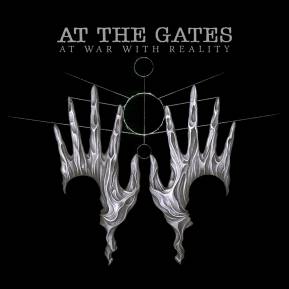
|
To co-ordinate the issue of At War With Reality, At The Gates inked an album contract with Century Media Records. “The folks at Century Media have been friends ever since the mid-90s, so they’re great friends,” the axe-slinger enthuses. “We have a history there with The Haunted, and Adrian (Erlandsson, drums) with Paradise Lost, and Tomas with Nightrage I think. We know them very well, and we also know that they give bands total creative freedom. You can do whatever you want, and they don’t force you or try to stop you doing anything. I mean, it’s the perfect label to be on. They have very good distribution means, and very good licensing deals with the rest of the world as well.”
At The Gates will embark on a tour of the United Kingdom in December. “We’re going over with Triptykon and Morbus Chron,” Anders tells. “It’s part of the European tour, which starts in the UK. It’s gonna be fun to go back and play some clubs in the UK – we haven’t since ’96, so it’s gonna be really fun.”
At The Gates reaches its 25th anniversary during 2015, causing fans to wonder as to whether the Swedes intend to mark the occasion. “Not any special plans, but yeah, we don’t even remember which day we started out,” the musician confesses. “I think it was the summer of ’90, somewhere in July maybe. We’ll look into that, maybe doing something special at some festival or something, but no record release or anything like that that I’m aware of. I don’t know.”
Anders plans to record a second solo full-length. “When I get the time from playing shows with At The Gates, I will try to write new songs,” he discloses. “There’s one song online that I put up a week ago or so on my home page, but apart from that, I will try to write new tracks next year. We’ll see, though. I have to find time to do that.”
Although touring as well as cutting material, each of At The Gates’ members are in everyday occupations. “I would say that At The Gates is considered like a hobby, but not like a project or anything,” the guitarist considers. “We want to stand with our feet rooted in reality somehow, and keep our day-jobs and our obligations at home – with family, kids and everything. It’s good to have a distance from this, and not to tour too much maybe. We have decided on maybe not touring that extremely much, and to keep it fresh, and basically not let the band dictate the economy of it – taking a show just to pay the rent, and stuff like that. I think it’s good to have a balance there. We have that ability with regular day-jobs, to pay the rent. We want to keep this as a very fun, professional hobby somehow.”
Within the music sphere, however, At The Gates is a central priority for each of its members. “I think so,” Anders judges. “I think we wouldn’t be in another band if we didn’t like it, so of course every band we’re in, we care for in a way. Yeah though, since we have a lot of shows booked, it would be stupid to say otherwise. For me personally, that’s very important to me. If I don’t feel that I’m satisfied within a group, I can’t be a part of it. That’s why I left The Haunted, for instance. At the time, we were five very different people both on a personal level and musically – very scattered – so it was hard.”
At War With Reality was released on October 24th, 2014 in Germany, Austria, Switzerland, and Finland, on the 27th in North America and the rest of Europe (excluding Italy, Spain, Poland, and Sweden), on the 28th in Italy, Spain, and Poland, on the 29th in Sweden, and on the 31st in Australia and New Zealand, all via Century Media Records. Japanese release occurred on the 29th through Trooper Entertainment.
Interview published in October 2014. All promotional photographs by Daniel Falk.
Related Posts via Categories
- SCOTTISH SICKNESS – A Report On The Scottish Death Metal Scene, Featuring BRAINBATH, PUTRID FATE And RANCID CADAVER (October 2022) | Features / Interviews @ Metal Forces
- LARVAE – Join The Hardcore Cult! (June 2022) | Features / Interviews @ Metal Forces Magazine
- TRENCH FOOT – Sacrificing Morals For Gory Obscenities (June 2022) | Features / Interviews @ Metal Forces Magazine
- L.A. GUNS – Trigger Happy (March 2019) | Features / Interviews @ Metal Forces Magazine
- CANCER – Crimes So Evil (November 2018) | Features / Interviews @ Metal Forces Magazine
- U.D.O. – The Tank Drives On (August 2018) | Features / Interviews @ Metal Forces Magazine
- SIEGE OF POWER – Bleeding For The Cause (August 2018) | Features / Interviews @ Metal Forces Magazine
- MOONSPELL – A Taste Of Live Eternity (August 2018) | Features / Interviews @ Metal Forces Magazine
- MONSTROSITY – Dark Matter Invocation (August 2018) | Features / Interviews @ Metal Forces Magazine
- SATAN – Five Magicians (August 2018) | Features / Interviews @ Metal Forces Magazine
|
|
